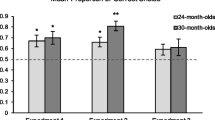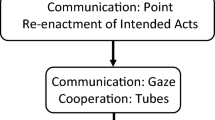Abstract
Although there has recently been considerable research interest in the difficulties that children with autism have engaging in pretend play, little attention has been paid to the ability of these children to imitate pretend play acts. Furthermore, suggestions that children with Down syndrome have relatively advanced abilities in pretend play have not been accompanied by an examination of their capacity to imitate pretend play. Three groups of children: autistic, Down syndrome, and normally developing were studied for their capacity to imitate single pretend acts and a series of pretend acts that formed scripts. While the children with autism were surprisingly better than the other two groups on the single-scheme task, they demonstrated specific difficulties on the multischeme task. Results are discussed in relation to current theories of autism and the notion of imitation.
Similar content being viewed by others
REFERENCES
Abrahamsen, E. P., & Mitchell, J. R. (1990). Communication and sensorimotor functioning in children with autism. Journal of Autism and Developmental Disorders, 20, 75–86.
American Psychiatric Association. (1994). Diagnostic and statistical manual of mental disorders (4th ed). Washington, DC: Author.
Atlas, J. A. (1990). Play in assessment and intervention in the childhood psychoses. Child Psychiatry and Human Development, 21, 119–133.
Bretherton, I. (1984). Representing the social world in symbolic play: Reality and fantasy. In I. Bretherton (Ed), Symbolic play: The development of social understanding. London: Academic Press.
Bruner, J., & Feldman, C. (1993). Theories of mind and the problem of autism. In S. Baron-Cohen, H. Tager-Flusberg, & D. J. Cohen (Eds.), Understanding other minds: Perspectives from autism. New York: Oxford.
Charman, T., & Baron-Cohen, S. (1994). Another look at imitation in autism. Development and Psychopathology, 6, 403–413.
Cohen, J. (1960). A coefficient of agreement for nominal sales. Educational and Psychological Measurement, 20, 37–46.
Curcio, F. (1978). Sensorimotor functioning and communication in mute autistic children. Journal of Autism and Childhood Schizophrenia, 8, 281–292.
Dawson, G., & Adams, A. (1984). Imitation and social responsiveness in autistic children. Journal of Abnormal Child Psychology, 12, 209–226.
Frith, U. (1989). Autism: Understanding the enigma. Oxford: Basil Blackwell.
Frith, U., & Snowling, M. (1983). Reading for meaning and reading for sound in autistic and dyslexic children. British Journal of Developmental Psychology, 1, 329–342.
Hammes, J. G. W., & Langdell, T. (1981). Precursors of symbol formation and childhood autism. Journal of Autism and Developmental Disorders, 11, 331–346.
Happé, F. (1994). Autism: An introduction to psychological theory. London: University College London Press.
Hill, P. M., & McCune-Nicholich, L. (1981). Pretend play and patterns of cognition in Down's Syndrome children. Child Development, 52, 611–617.
Heimann, M., Ullstadius, E., Dahlgren, S. O. & Gillberg, C. (1992). Imitation in autism: A preliminary research note. Behavioral Neurology, 5, 219–227.
Jarrold, C, Boucher, J., & Smith, P. (1993). Symbolic play in autism: A review. Journal of Autism and Developmental Disorders, 23, 281–309.
Jarrold, C, Smith, P., Boucher, J., & Harris, P. (1994). Children with autism's comprehension of pretence. Journal of Autism and Developmental Disorders, 24, 433–456.
Jordan, R. (1993). The nature of linguistic and communication difficulties of children with autism. In D. Messer & G. Turner (eds.), Critical influences on child language acquisition and development. New York: St. Martin's Press.
Kavanaugh, R. D., & Harris, P. L. (1994). Imagining the outcome of pretend transformations: Assessing the competence of normal children and children with autism. Developmental Psychology, 30, 847–854.
Koegel, R. L., Rincover, A., & Egel, A. L. (1982). Educating and understanding autistic children. San Diego: College Hill.
Leslie, A. M. (1987). Pretense and representation: The origins of ‘theory of mind’. Psychological Review, 94, 412–426.
Lewis, V., & Boucher, J. (1988). Spontaneous, instructed and elicited play in relatively able autistic children. British Journal of Developmental Psychology, 6, 325–337.
Loveland, K., & Tunali, B. (1993). Narrative language in autism and the theory of mind hypothesis: A wider perspective. In S. Baron-Cohen, H. Tager-Flusberg, & D. J. Cohen (eds.), Understanding other minds: Perspectives from autism. New York: Oxford.
McEvoy, R., Loveland, K., & Landry, S. (1988). The functions of immediate echolalia in autistic children: A developmental perspective. Journal of Autism and Developmental Disorders, 18, 657–668.
Meltzoff, A. N., & Gopnik, A. (1993). The role of imitation in understanding persons and developing a theory of mind. In S. Baron-Cohen, H. Tager-Flusberg, & D. J. Cohen (Eds.), Understanding other minds: Perspectives from autism. New York: Oxford.
Meltzoff, A. N., & Moore, M. K. (1977). Imitation of facial and manual gestures by human neonates. Science, 198, 75–78.
Meltzoff, A. N., & Moore, M. K. (1983). Newborn infants imitate adult facial gestures. Child Development, 54, 702–709.
Meltzoff, A. N., & Moore, M. K. (1989). Imitation in newborn infants: Exploring the range of gestures imitated and the underlying mechanism. Developmental Psychology, 25, 954–962.
Morgan, S. B., Cutrer, P. S., Coplin, J. W., & Rodrigue, J. R. (1989). Do autistic children differ from retarded and normal children in Piagetian sensorimotor functioning? Journal of Child Psychology and Psychiatry, 30, 857–864.
Motti, F., Cicchetti, D., & Sroufe, L. A. (1983). From infant affect expression to symbolic play: The coherence of development in Down Syndrome Children. Child Development, 54, 1168–75.
Ohta, M. (1987). Cognitive disorders of infantile autism: A study employing the WISC, spatial relationship conceptualization, and gesture imitations. Journal of Autism and Developmental Disorders, 17, 45–62.
Reynell, J. K., & Huntley, M. (1987). Reynell Developmental Language Scale (3rd ed.). Windsor, Ontario: NFER-Nelson.
Riguet, C. B., Taylor, N. D., Benaroya, S., & Klein, L. S. (1981). Symbolic play in autistic, Down's and normal children of equivalent mental age. Journal of Autism and Developmental Disorders, 11, 439–448.
Rogers, S. J., & Pennington, B. F. (1991). A theoretical approach to the deficit in infantile autism. Development and Psychopathology, 3, 137–162.
Shimada, S. (1990). Relationship between pretend play and expressive language in Down's Syndrome young children. RIEEC Report, 39, 55–63.
Sigman, M., & Ungerer, J. (1984). Cognitive and language skills in autistic children. Developmental Psychology, 20, 149–165.
Smith, I. M., & Bryson, S. E. (1994). Imitation and action in autism: A critical review. Psychological Bulletin, 116, 259–273.
Stone, W. L., Lemanek, K. L., Fischel, P T., Fernadez, M. C., & Altemeier, W. A. (1990). Play and imitation skills in the diagnosis of autism in young children. Pediatrics, 86, 267–272.
Thal, D., & Bates, E. (1988). Language and gesture in late talkers. Journal of Speech and Hearing Research, 31, 115–123.
Ungerer, J. A., & Sigman, M. (1981). Symbolic play and language comprehension in autistic children. Journal of the American Academy of Child Psychiatry, 20, 318–337.
Vygotsky, L. S. (1964). Thought and language. New York: Wiley.
Wing, L., Gould, J., Yeates, S. R., & Brierley, L. M. (1977). Symbolic play in severely mentally retarded and in autistic children. Journal of Child Psychology and Psychiatry, 18, 167–178.
Wing, L., & Gould, J. (1979). Severe impairments of social interaction and associated abnormalities in children: Epidemiology and classification. Journal of Autism and Developmental Disorders, 9, 11–29.
Wulff, S. B. (1985). The symbolic play and object play of children with autism: A review. Journal of Autism and Developmental Disorders, 15, 139–148.
Author information
Authors and Affiliations
Rights and permissions
About this article
Cite this article
Libby, S., Powell, S., Messer, D. et al. Imitation of Pretend Play Acts by Children with Autism and Down Syndrome. J Autism Dev Disord 27, 365–383 (1997). https://doi.org/10.1023/A:1025801304279
Issue Date:
DOI: https://doi.org/10.1023/A:1025801304279




